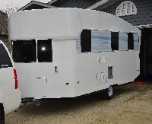Tnttt has broken me down and I find myself thinking about a 3.5 m/11’6” three person caravan. I have wheels, torsion suspension halves (lightly used), hydraulic coupling, rotor hubs and callipers. Yesterday I bought the steel, which is one way of getting started. (The other way is to draw up a detailed plan, which I haven't done yet).
I am no craftsman, I could probably get a job as an bodger but only if there was a leading hand bodger to show me how to do the tricky bits.
I fancy vacuum bagging the walls as a composite...1mm aluminium, 50mm (2 inch) foamular and 6mm or 9mm (1/4 or 3/8ths) treated plywood epoxied together. I am off to buy the foam tomorrow. My neighbour brought me his heavy duty vacuum pump. It ran a dairy once. I could bolt down my compressor and run the pump off the compressor motor which is about 3hp.
Does anyone have any experience of vacuum bagging walls? I am doing it because I believe the pressure (one might manage one thousand pounds per square foot) improves the epoxy bond but is this true? Of two composites manufacturers who I checked on, one did it this way the other other had a huge press so they believe in pressure. But often pressure is used to force epoxy through glassfibre laminate and I am not doing that, just using epoxy as glue. Views welcome, experiences particularly welcome. I should not be surprised if vacuum bagging is a stupid idea, I have had stupid ideas before now.
Hope “foamies” is the right forum for this question.
Next week I shall start a build journal and I will submit photos
composite walls
Moderator: eaglesdare
22 posts
• Page 1 of 2 • 1, 2
-

hossesdad - Teardrop Advisor
- Posts: 70
- Images: 178
- Joined: Fri Sep 02, 2016 5:19 am
- Location: New Zealand
Re: composite walls
Just sharing my experience: I feel that 3mm plywood is more than enough for internal skin in a wall foam sandwich. More will just add weight. I also feel that my 1.5in foamular foam is more than enough of wall thickness. My next build will probably be just 1in foam. 1mm aluminum skin seems to be also too thick to me, but all it is of course my personal preference.
I have not tried epoxy glue-up vacuum press on large surfaces yet, I used bricks to glue panels and found that epoxy gives me a very good working time comparing to TB2(dries too fast). Lately I started using PL Premium glue instead of epoxy for gluing plywood to foam and I like the outcome so far, I used a notched spreader for PL and bricks for clamping on large panels at home. PL is more economical than epoxy and less toxic. I would probably use epoxy for gluing aluminum to XPS foam though, as PL requires porous surface, while epoxy does not. I think that I would still use PL if I was gluing EPS(white beaded, not an xps foam) to aluminum because EPS is porous.
I have not tried epoxy glue-up vacuum press on large surfaces yet, I used bricks to glue panels and found that epoxy gives me a very good working time comparing to TB2(dries too fast). Lately I started using PL Premium glue instead of epoxy for gluing plywood to foam and I like the outcome so far, I used a notched spreader for PL and bricks for clamping on large panels at home. PL is more economical than epoxy and less toxic. I would probably use epoxy for gluing aluminum to XPS foam though, as PL requires porous surface, while epoxy does not. I think that I would still use PL if I was gluing EPS(white beaded, not an xps foam) to aluminum because EPS is porous.
-

OP827 - Donating Member
- Posts: 1596
- Images: 414
- Joined: Fri Apr 25, 2014 7:27 pm
- Location: Bruce County Ontario





